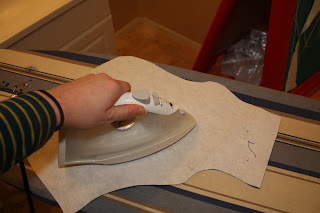
Our first:
The first FHE chart we had I started at a relief society activity - I was really excited to make it since it reminded me so much of the one my family used growing up.
I didn't actually finish the chart that night, but I had taken 6 "heads" (although I only had 1 child at the time...I may have even been pregnant with him?) and I finished it at home later...my own way.
I decided I wanted the heads to stay put so we could be in order and I didn't actually get around to finishing the chart until I had 2 kids, so the bottom two circles were just painted and left blank until the twins were born a few years later.
I bought the little wooden pictures from Michaels to represent the different things we wanted as part of our FHE - I tried different things at different times, so I stuck the extras onto the back with more velcro so we could edit our 'agenda' from time to time. (The family's hair is made using embroidery floss I had in my stash.)
Our various parts (we used only 6 of these at a time):
- Welcome (obviously, "welcome")
- Prayer (opening or closing, sheep)
- Song (I had a note at some point?)
- Activity song (hand)
- Lesson (book)
- Activity (behive or pencil)
- Treat (cupcake)
- Talent (star)
- Article of Faith (bee-leaf...get it? belief.)
Our current:
Then, we had another kid, and I wanted a new chart...so I finally got around to making one. "Just in case" (and to accommodate guests for FHE), I added an extra spot on this chart for a total of 8. We leave the "?" at prayer until we have a guest over. We used to rotate ? and whoever had the welcome could do both or I came up with that part (?) for FHE.
I (machine) embroidered these designs onto fabric, then sewed on 8 clear vinyl pockets (the vinyl squares have brown satiny ribbon folded over the cut edges before being sewn onto the fabric) - I didn't put a lot of forethought into placement since I was new to embroidery, so the pocket placement isn't perfectly even, but (surprisingly) this doesn't bother me.
Blank, it looked like this:
When I added the letter circles, the bottom bunched a little from the weight,
So I added another dowel in the bottom (I didn't want to undo my side seams to make a casing between the layers, so I just folded the bottom up around the dowel and stitched it in place then re-inserted the dowel.)
To make the circles, I saved the lids from 8 can of (del monte) spaghetti sauce and covered them with fabric that had been embroidered with the initial of a family member. I used hot glue and I glued a circle onto the back to cover the edges of the front circle. They have held up nicely.
My only regret is the font I used...the kids had to get used to the way their letters looked.
This time I made the placement of activities fixed (so the "welcome person" - conducting person - knows where to start and end) - and the family rotates around.
Our current agenda:
- Welcome
- Opening Song
- Opening Prayer
- Lesson
- Activity (movement) song
- Article of Faith (which we also sing - all together)
- Fine Arts/Talent
- Closing Prayer
We move straight down the middle - the initial circles alternate sides of that middle agenda.
We decided treats weren't necessary to FHE - if we want a treat, we'll call it dessert and eat it when we eat dinner - it made the bedtime routine flow smoother.
And in a few years when the kids get older and we don't need a wiggle song or they all know all the articles of faith, I'll probably edit it again and make a new one. :)































































